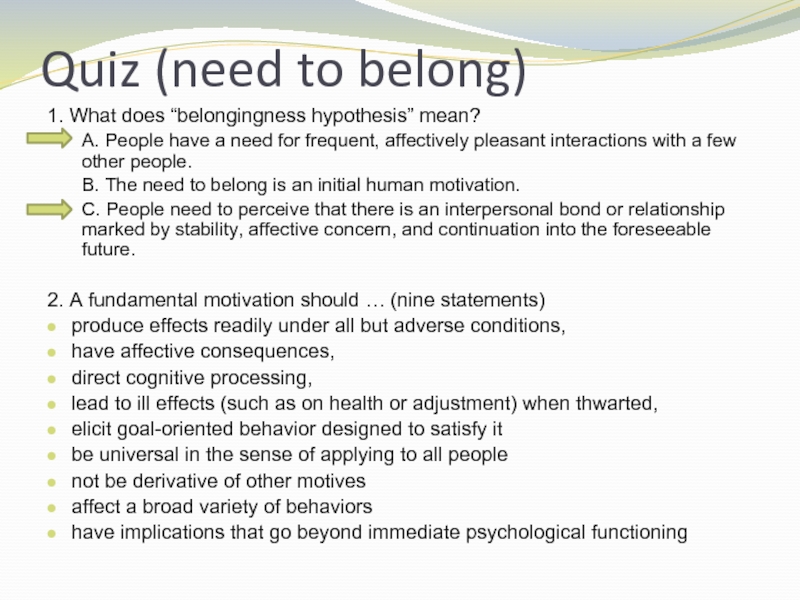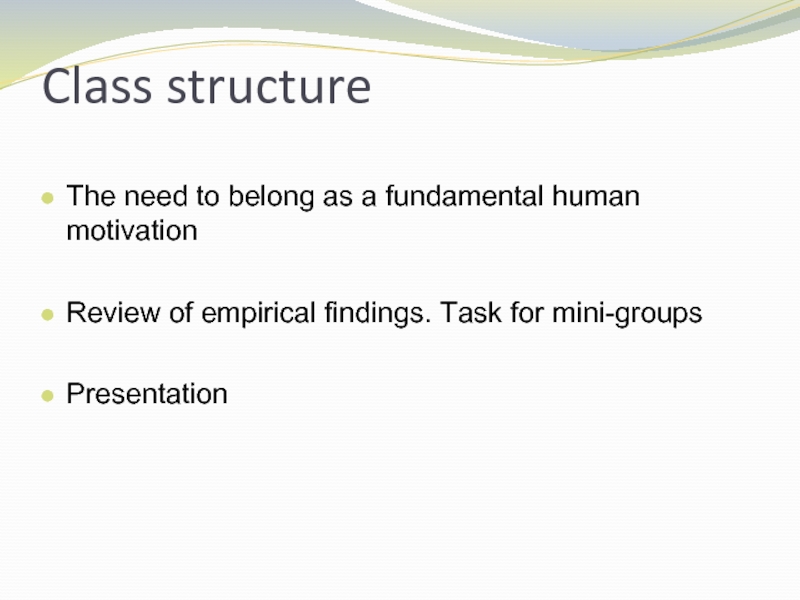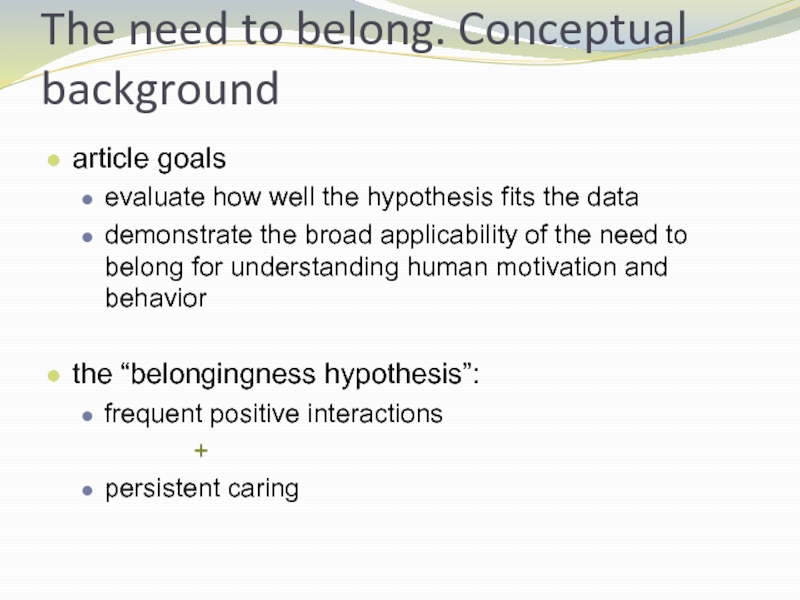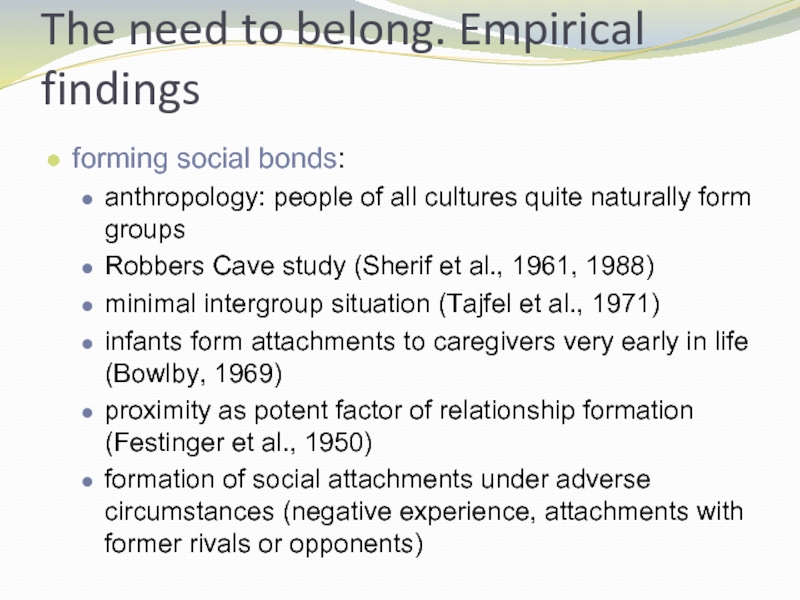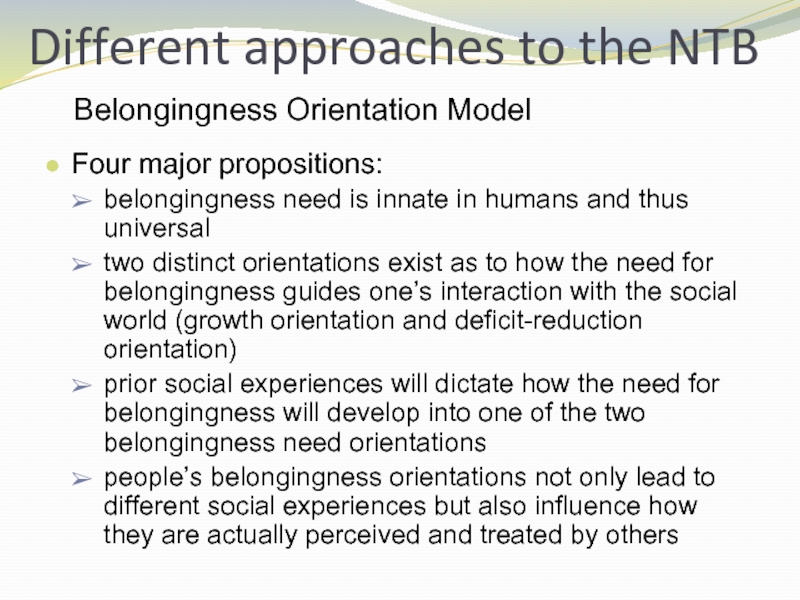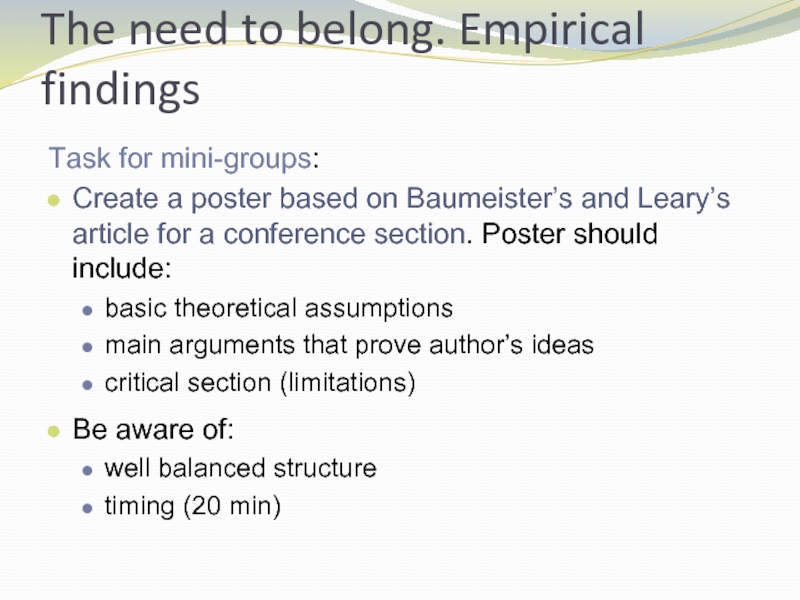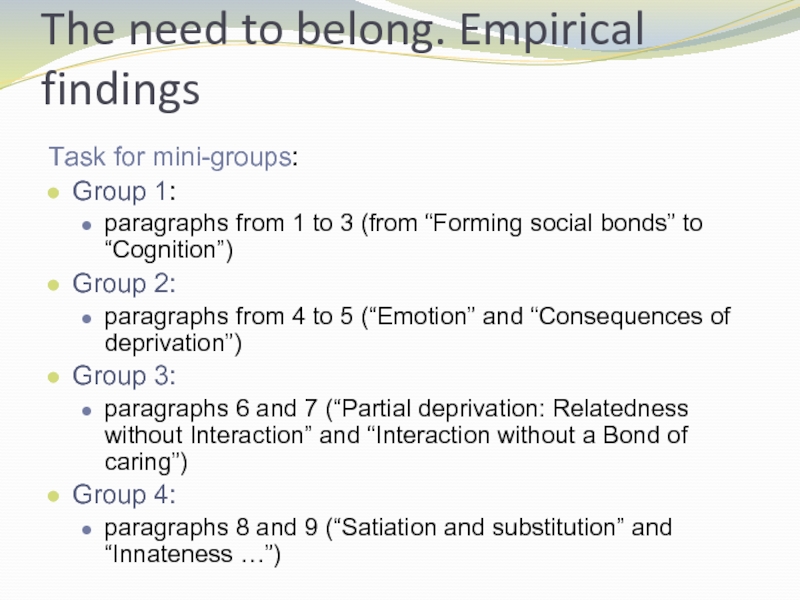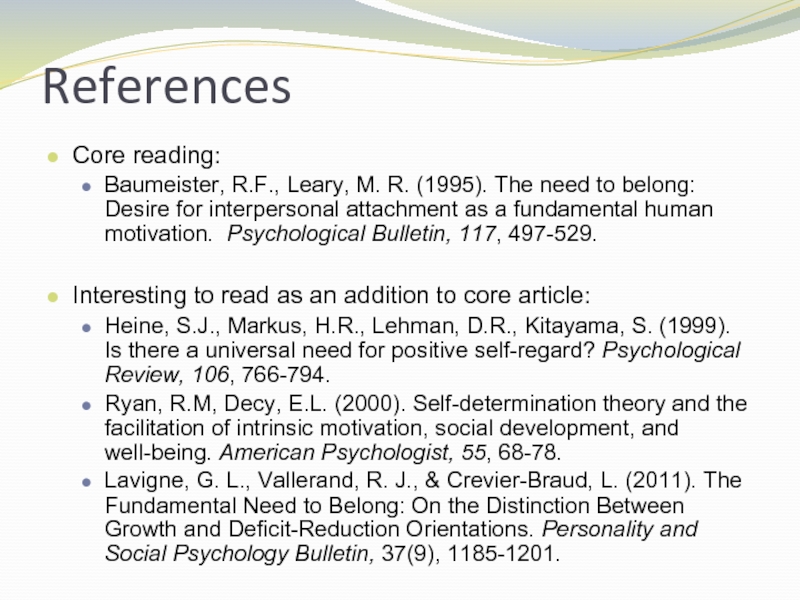- Главная
- Разное
- Дизайн
- Бизнес и предпринимательство
- Аналитика
- Образование
- Развлечения
- Красота и здоровье
- Финансы
- Государство
- Путешествия
- Спорт
- Недвижимость
- Армия
- Графика
- Культурология
- Еда и кулинария
- Лингвистика
- Английский язык
- Астрономия
- Алгебра
- Биология
- География
- Детские презентации
- Информатика
- История
- Литература
- Маркетинг
- Математика
- Медицина
- Менеджмент
- Музыка
- МХК
- Немецкий язык
- ОБЖ
- Обществознание
- Окружающий мир
- Педагогика
- Русский язык
- Технология
- Физика
- Философия
- Химия
- Шаблоны, картинки для презентаций
- Экология
- Экономика
- Юриспруденция
Need to belong. Interpersonal behavior презентация
Содержание
- 1. Need to belong. Interpersonal behavior
- 2. Quiz (need to belong) 1. What does
- 3. Class structure The need to belong as
- 4. The need to belong. Conceptual background article
- 5. The need to belong. Empirical findings forming
- 6. Different approaches to the NTB Psychological need
- 7. Different approaches to the NTB Four major
- 8. The need to belong. Empirical findings Task
- 9. The need to belong. Empirical findings Task
- 10. References Core reading: Baumeister, R.F., Leary, M.
Слайд 2Quiz (need to belong)
1. What does “belongingness hypothesis” mean?
A. People have
a need for frequent, affectively pleasant interactions with a few other people.
B. The need to belong is an initial human motivation.
C. People need to perceive that there is an interpersonal bond or relationship marked by stability, affective concern, and continuation into the foreseeable future.
2. A fundamental motivation should … (nine statements)
produce effects readily under all but adverse conditions,
have affective consequences,
direct cognitive processing,
lead to ill effects (such as on health or adjustment) when thwarted,
elicit goal-oriented behavior designed to satisfy it
be universal in the sense of applying to all people
not be derivative of other motives
affect a broad variety of behaviors
have implications that go beyond immediate psychological functioning
B. The need to belong is an initial human motivation.
C. People need to perceive that there is an interpersonal bond or relationship marked by stability, affective concern, and continuation into the foreseeable future.
2. A fundamental motivation should … (nine statements)
produce effects readily under all but adverse conditions,
have affective consequences,
direct cognitive processing,
lead to ill effects (such as on health or adjustment) when thwarted,
elicit goal-oriented behavior designed to satisfy it
be universal in the sense of applying to all people
not be derivative of other motives
affect a broad variety of behaviors
have implications that go beyond immediate psychological functioning
Слайд 3Class structure
The need to belong as a fundamental human motivation
Review of
empirical findings. Task for mini-groups
Presentation
Presentation
Слайд 4The need to belong. Conceptual background
article goals
evaluate how well the hypothesis
fits the data
demonstrate the broad applicability of the need to belong for understanding human motivation and behavior
the “belongingness hypothesis”:
frequent positive interactions
+
persistent caring
demonstrate the broad applicability of the need to belong for understanding human motivation and behavior
the “belongingness hypothesis”:
frequent positive interactions
+
persistent caring
Слайд 5The need to belong. Empirical findings
forming social bonds:
anthropology: people of all
cultures quite naturally form groups
Robbers Cave study (Sherif et al., 1961, 1988)
minimal intergroup situation (Tajfel et al., 1971)
infants form attachments to caregivers very early in life (Bowlby, 1969)
proximity as potent factor of relationship formation (Festinger et al., 1950)
formation of social attachments under adverse circumstances (negative experience, attachments with former rivals or opponents)
Robbers Cave study (Sherif et al., 1961, 1988)
minimal intergroup situation (Tajfel et al., 1971)
infants form attachments to caregivers very early in life (Bowlby, 1969)
proximity as potent factor of relationship formation (Festinger et al., 1950)
formation of social attachments under adverse circumstances (negative experience, attachments with former rivals or opponents)
Слайд 6Different approaches to the NTB
Psychological need for affiliation = a concern
for establishing and maintaining positive relationships with another person or group (McClelland, 1985)
People differ in the strength to which they have this need, but its origins remained unclear
Individuals high in the need for affiliation were energized to behave in an affiliative way, were more sensitive to affiliative cues, and learned affiliative associations faster than individuals with a low need for affiliation (Atkinson & Walker, 1958; Boyatzis, 1972; Constantian, 1981; Lansing & Heyns, 1959; McClelland, 1975, 1985).
Self-determination theory (Deci & Ryan, 2000): people hold a basic psychological need to relate to, to connect, to care for and be cared for by significant others and satisfying it provides optimal functioning
People differ in the strength to which they have this need, but its origins remained unclear
Individuals high in the need for affiliation were energized to behave in an affiliative way, were more sensitive to affiliative cues, and learned affiliative associations faster than individuals with a low need for affiliation (Atkinson & Walker, 1958; Boyatzis, 1972; Constantian, 1981; Lansing & Heyns, 1959; McClelland, 1975, 1985).
Self-determination theory (Deci & Ryan, 2000): people hold a basic psychological need to relate to, to connect, to care for and be cared for by significant others and satisfying it provides optimal functioning
Слайд 7Different approaches to the NTB
Four major propositions:
belongingness need is innate
in humans and thus universal
two distinct orientations exist as to how the need for belongingness guides one’s interaction with the social world (growth orientation and deficit-reduction orientation)
prior social experiences will dictate how the need for belongingness will develop into one of the two belongingness need orientations
people’s belongingness orientations not only lead to different social experiences but also influence how they are actually perceived and treated by others
two distinct orientations exist as to how the need for belongingness guides one’s interaction with the social world (growth orientation and deficit-reduction orientation)
prior social experiences will dictate how the need for belongingness will develop into one of the two belongingness need orientations
people’s belongingness orientations not only lead to different social experiences but also influence how they are actually perceived and treated by others
Belongingness Orientation Model
Слайд 8The need to belong. Empirical findings
Task for mini-groups:
Create a poster based
on Baumeister’s and Leary’s article for a conference section. Poster should include:
basic theoretical assumptions
main arguments that prove author’s ideas
critical section (limitations)
Be aware of:
well balanced structure
timing (20 min)
basic theoretical assumptions
main arguments that prove author’s ideas
critical section (limitations)
Be aware of:
well balanced structure
timing (20 min)
Слайд 9The need to belong. Empirical findings
Task for mini-groups:
Group 1:
paragraphs from 1
to 3 (from “Forming social bonds” to “Cognition”)
Group 2:
paragraphs from 4 to 5 (“Emotion” and “Consequences of deprivation”)
Group 3:
paragraphs 6 and 7 (“Partial deprivation: Relatedness without Interaction” and “Interaction without a Bond of caring”)
Group 4:
paragraphs 8 and 9 (“Satiation and substitution” and “Innateness …”)
Group 2:
paragraphs from 4 to 5 (“Emotion” and “Consequences of deprivation”)
Group 3:
paragraphs 6 and 7 (“Partial deprivation: Relatedness without Interaction” and “Interaction without a Bond of caring”)
Group 4:
paragraphs 8 and 9 (“Satiation and substitution” and “Innateness …”)
Слайд 10References
Core reading:
Baumeister, R.F., Leary, M. R. (1995). The need to belong:
Desire for interpersonal attachment as a fundamental human motivation. Psychological Bulletin, 117, 497-529.
Interesting to read as an addition to core article:
Heine, S.J., Markus, H.R., Lehman, D.R., Kitayama, S. (1999). Is there a universal need for positive self-regard? Psychological Review, 106, 766-794.
Ryan, R.M, Decy, E.L. (2000). Self-determination theory and the facilitation of intrinsic motivation, social development, and well-being. American Psychologist, 55, 68-78.
Lavigne, G. L., Vallerand, R. J., & Crevier-Braud, L. (2011). The Fundamental Need to Belong: On the Distinction Between Growth and Deficit-Reduction Orientations. Personality and Social Psychology Bulletin, 37(9), 1185-1201.
Interesting to read as an addition to core article:
Heine, S.J., Markus, H.R., Lehman, D.R., Kitayama, S. (1999). Is there a universal need for positive self-regard? Psychological Review, 106, 766-794.
Ryan, R.M, Decy, E.L. (2000). Self-determination theory and the facilitation of intrinsic motivation, social development, and well-being. American Psychologist, 55, 68-78.
Lavigne, G. L., Vallerand, R. J., & Crevier-Braud, L. (2011). The Fundamental Need to Belong: On the Distinction Between Growth and Deficit-Reduction Orientations. Personality and Social Psychology Bulletin, 37(9), 1185-1201.

